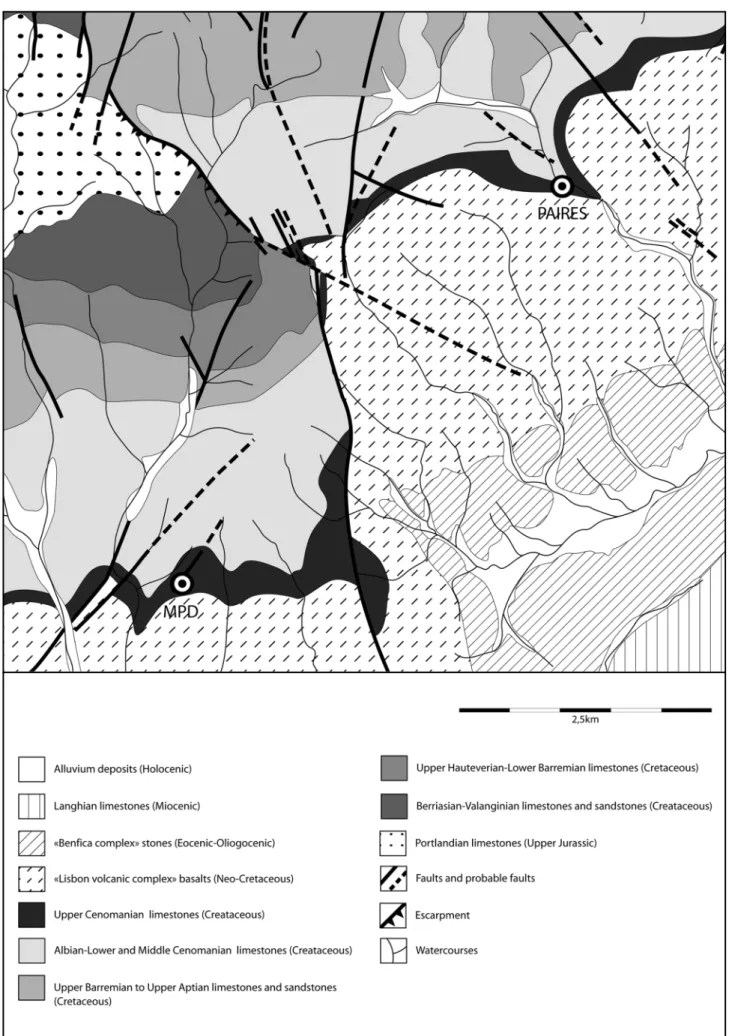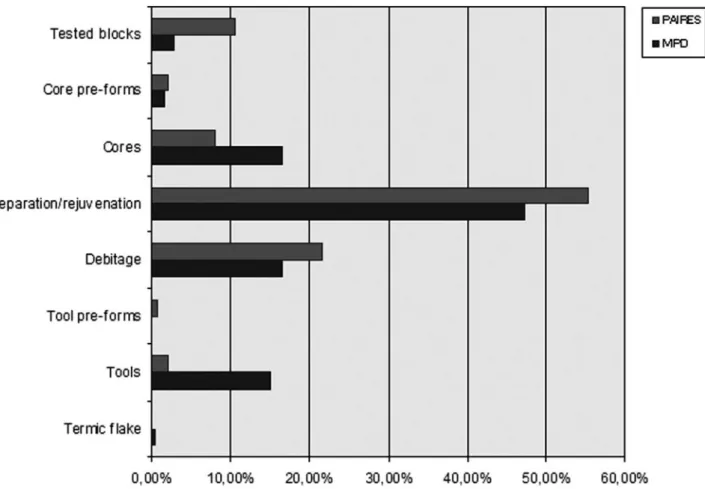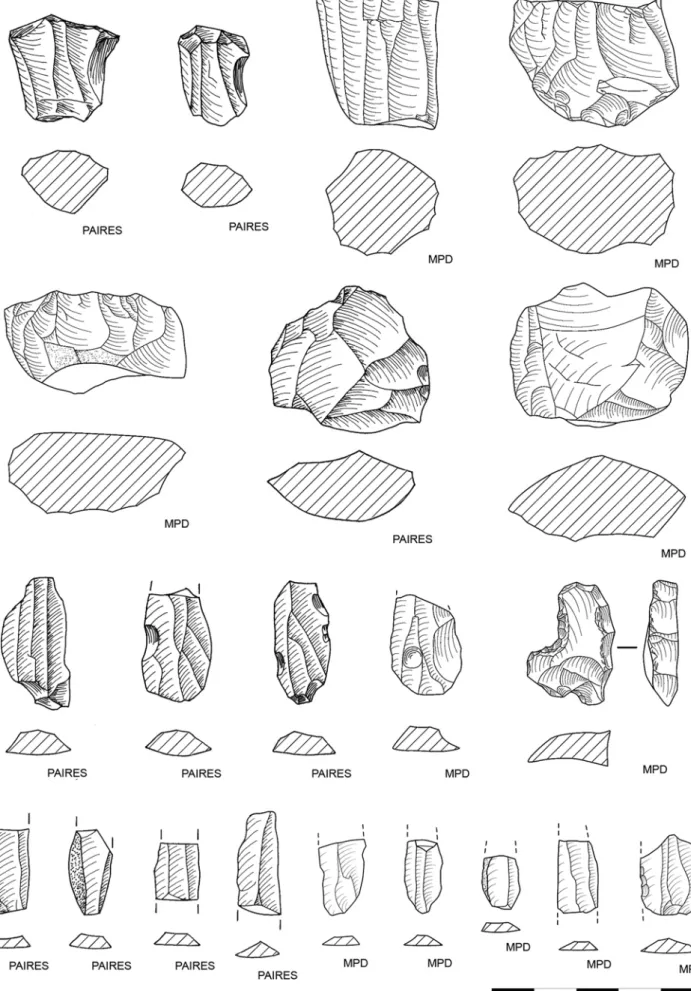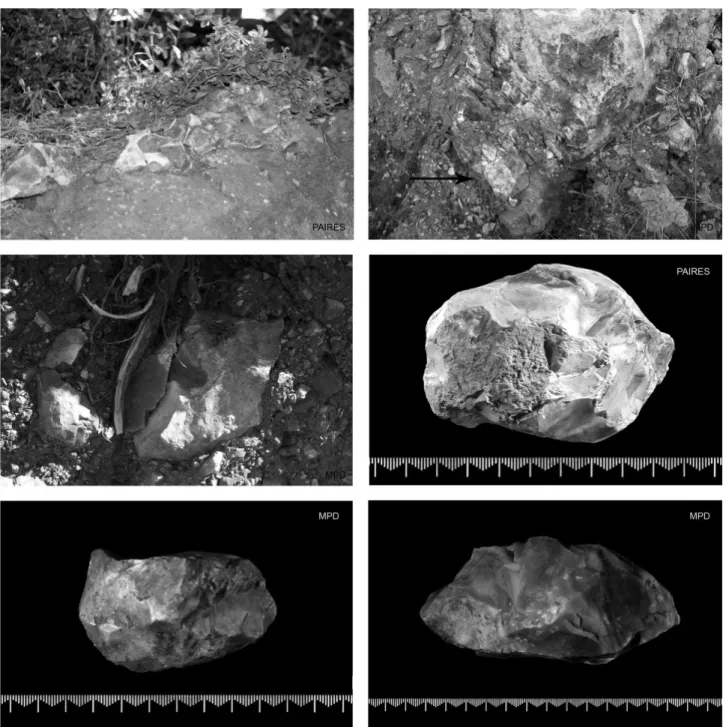Proceedings of the 2nd
International
Conference of the UISPP
Commission on Flint Mining
in Pre- and Protohistoric Times
(Madrid, 14-17 October 2009)
Edited by
Marta Capote
Susana Consuegra
Pedro Díaz-del-Río
Xavier Terradas
BAR International Series 2260
2011
Published by Archaeopress
Publishers of British Archaeological Reports Gordon House
276 Banbury Road Oxford OX2 7ED England
bar@archaeopress.com www.archaeopress.com
BAR S2260
Proceedings of the 2nd
International Conference of the UISPP Commission on Flint Mining in Pre- and
Protohistoric Times (Madrid, 14-17 October 2009)
© Archaeopress and the individual authors 2011
ISBN 978 1 4073 0831 9
Cover figure: Last mining event at Casa Montero, Madrid (c. 5200 cal BC). Illustration by Juan Álvarez-Cebrián
Printed in England by Blenheim Colour Ltd All BAR titles are available from:
Hadrian Books Ltd 122 Banbury Road Oxford OX2 7BP England www.hadrianbooks.co.uk
The current BAR catalogue with details of all titles in print, prices and means of payment is available free from Hadrian Books or may be downloaded from www.archaeopress.com
149
1. Geographic, geological and archaeological contexts of Pedreira do Aires and Monte das Pedras
The Neolithic sites of Pedreira do Aires and Monte das Pedras are located in the lower Lisbon Peninsula, in the area of infl uence of the Tagus estuary (Figure 1). They refl ect different implantation models. The fi rst site is lo-cated at the bottom of a gentle slope, on the bank of a stream, without good visibility over the surrounding area. The second is located at the top of a large platform boun-ded by the deep valleys of two confl uent streams; visibi-lity over the surrounding area is very good, and a visual relationship with synchronic settlements and funerary areas existed.
Geologically, both sites are located on a strip of Upper Cenomanian limestone (Cretaceous) separating the basalts of the ‘Lisbon volcanic complex’ from Albian-Lower and Middle Cenomanian limestone (Figure 2). Flint nodules are present in the exposed outcrops of this limestone strip. They are also found in a secondary position in adjacent
debris levels and along the banks of streams. In the imme-diate vicinity of Pedreira do Aires and Monte das Pedras several sites of similar age existed, possibly part of the same settlement network.
The archaeological context of Pedreira do Aires includes several megalithic monuments (dolmens of Trigache 1 to 4, Pedras Grandes and Batalhas), several poorly defi ned Neolithic and Chalcolithic settlements (Castelo da Amo-reira, Quinta do Castelo Nascente, Gaitadas and Casal do Murtal) and other possible fl int ‘mines’/workshops (Ca-sal Novo and the Pedernais Cave). The archaeological context of Monte das Pedras includes several megalithic monuments of different typology (the rock-cut tombs of Carenque 1 to 4 and Baútas, the dolmens of Pego Lon-go, Monte Abraão, Estria, Pedra dos Mouros and Carras-cal, and the tholoi of Agualva and Pedreira do Campo), several Neolithic and Chalcolithic settlements (Serra das Éguas, Espargueira, Baútas and Tojal de Vila Chã Norte) and another possible fl int ‘mine’/workshop (Moinhos da Funcheira).
Pedreira do Aires and Monte das Pedras:
two Neolithic flint ‘mines’ in
the Lisbon Peninsula
Marco António ANDRADE and Henrique MATIAS
Abstract
This paper describes the Neolithic sites of Pedreira do Aires and Monte das Pedras, both located in the Lisbon Peninsula, Portugal. The archaeological assemblages recovered from these sites - mostly lithic materials such as debitage debris, both ‘tested’ and shaped fl int blocks, preparation fl akes and core rejuvenation elements - and the geological context (Upper Cenomanian limestone rich in fl int nodules), suggest that both should be interpreted as fl int extraction localities (although not necessarily mines, the fl int being recovered in a secondary position from detritic deposits) and occasional workshops oriented towards bladelet production. These sites can therefore be understood as small, seasonal campsites located within the sphere of infl uence of a larger settlement and part of a complex spatial use and resource exploitation network that lasted from the 5th to the 3rd millennia BC (the Neolithic and Chalcolithic of the region). Models of fl int procurement must take into account that different types of site existed: settlements, funerary sites and resource procurement sites. The relationship with contextually similar sites highlights the strategies used in the exploitation of fl int at this time in the Lisbon Peninsula.
Keywords
Proceedings of the 2nd Conference of the UISPP Commission on Flint Mining...
3) core pre-forms (fl int blocks from which the cortex has been totally or partially removed).
4) tool pre-forms (unfi nished tools).
5) prismatic cores abandoned in the full debitage stage (not exhausted).
6) core preparation and rejuvenation elements (cortical and partly cortical fl akes, fl anks, tablets).
7) fi nished tools (few in number compared to the number of debitage debris and rejuvenation elements).
Unworked and ‘tested’ fl int nodules and cobbles (with less than three fl akes extracted) along with cortex remo-val fl akes are abundant at both sites. This abundance pre-vented the systematic sampling of these items; they are therefore not considered in the statistical analysis (Figure 3). The discarding of such blocks after experimentation is possibly due to their poor quality (presence of geodes and cleavages). This problem also affected later phases of production; the majority of prismatic cores show scars of hinged removals (possibly the reason for their being aban-doned).
The recovered tools include retouched blades, bladelets and fl akes, as well as scrapers, notches, denticulates and perforators. An arrowhead pre-form was also found at Pe-dreira do Aires. The presence of these artifacts could be the result of in loco knapping (confi rming the vocation of both sites as workshops, even if only occasionally). Al-ternatively, they may simply represent the discarding of tools made elsewhere. At Monte das Pedras, cortical or partly cortical fl akes were used (albeit not exclusively) as the blanks for tools (mostly retouched fl akes, scrapers and denticulates), suggesting a rigorous economy of raw ma-terial use.
Bladelet production is attested to at both sites by the pre-sence of prismatic bladelet cores and core rejuvenation elements with bladelet extraction negatives, as well as by tool blanks (Figure 4). These were mostly extracted using pressure fl aking with heat pre-treatment of the cores in-tended to facilitate the knapping process, confi rming the Neolithic chronology of both sites. The presence of cres-ted bladelets and cortical/partly cortical bladelets indicates that the fi rst stages of the production of these artifacts took place at the extraction sites. However, several exhausted bladelet cores indicate that the subsequent stages of the reduction sequence was also undertaken in these places. The colour of most Pedreira do Aires and Monte das Pe-dras fl ints (blocks, cores and artifacts) varies between light/ dark grey and greyish green, typical of Upper Cenoma-nian geological contexts. Flints of different colour (white, pinkish red, reddish brown and yellowish green) are also present, although none is inconsistent with the geological source (Almeida, Araújo and Aubry 2003). Moreover, at The above indicates that organized communities with
well limited, functionally specialized areas of occupation (e.g., for settlement, burial or resource procurement) exis-ted between the Late Neolithic (identifi ed by denexis-ted-rim and carenated bowls found in settlements and by engra-ved schist plaques at funerary sites) and the Late Chalco-lithic (recognized by the presence of bell-beaker pottery at settlements and funerary sites). The Early Neolithic of the area is poorly known and is currently represented only by a few shards of pottery decorated with incised or im-pressed motifs and a few geometric microliths found at the settlements of Espargueira and Baútas. Nonetheless, an important settlement from this time, Zibreira, is located 3km north of Monte das Pedras.
2. Context of archaeological data recovery and of the studied assemblages
The Pedreira do Aires and Monte das Pedras sites fi nd themselves in an advanced state of destruction, which se-riously undermines their potential for archaeological in-terpretation. Recent excavations have detected no in situ-preserved contexts.
The analysis of the recovered assemblages and their geo-logical contexts show both sites were dedicated to a spe-cifi c activity during the Neolithic and (possibly) the Chal-colithic: the exploitation, extraction and procurement of siliceous raw materials, with the occasional production of knapped artifacts. Lithic materials are abundant at both si-tes, corresponding to about 98% of all archaeological fi nds and characterized by the presence of:
1) exploitation and debitage debris (preparation fl akes re-fl ecting the fi rst stages of prismatic debitage).
2) shaped fl int blocks and their respective cortex removal fl akes.
Figure 1. Location of Pedreira do Aires and Monte das Pedras in the geographical context of the Iberian Peninsula.
151
M. A. Andrade and H. Matias: Pedreira do Aires and Monte das Pedras: two Neolithic flint ‘mines’...
Proceedings of the 2nd Conference of the UISPP Commission on Flint Mining...
presence of large blades and dented-rim bowls) - a period of some 1600 years (4500-2900 BC). Chalcolithic use can be hypothesized given nearby settlement evidence, but at present this is not supported by diagnostic fi nds.
3. Flint procurement at Pedreira do Aires and Monte das Pedras: primary position vs secondary position
As mentioned above, both sites are located on a strip of Upper Cenomanian limestone where fl int can be found in a primary position embedded in the rock matrix, as well as in secondary positions on a slope and in the alluvial de-posits of the valley bottoms (Figure 5). In Portugal, there are countless geological formations with rocks appropriate for knapping (Portuguese Geological Chart, Instituto
Geo-lógico e Mineiro) although most are found in a secondary
position in debris deposits (Almeida, Araújo and Aubry 2003).
Simple macroscopic observation of an artifact’s cortex can indicate the kind of source that was exploited. Most of the knapped blocks, as well as the blanks, show a rolled cor-tex with characteristic impact marks made during fl uvial transport. The preferred source for collecting fl int was the-refore secondary deposits on river terraces. Some of the both sites fl int gradually darkens from the surface to the
core, a consequence of weathering. Therefore, differently coloured fl ints may not only have come from the same source, they may even have belonged to the same original blocks.
Tools related to the extraction of raw materials and the production of artifacts have also been recovered. These in-clude a hammerstone/anvil made from a quartzite cobble from Pedreira do Aires that features a characteristic dome-shaped depression created by percussion (used in bipolar core debitage), as well percussion marks on its edges. Pottery is represented by a few, mostly uncharacteristic shards. The only element with a clear chronological attri-bution is the fragment of a dented-rim bowl recovered at Monte das Pedras, which is typical of the Late Neolithic of Portuguese Estremadura (c. 3300-2900 BC).
The above data suggest that both sites functioned as fl int procurement localities and occasional workshops over an extended, although not necessarily continuous, period of time. This period may have begun in the later part of the Early Neolithic, as indicated by the presence of lithic artifacts characteristic of this period (small sized blades, bladelets and perforators made from fl akes), and conti-nued until at least the Late Neolithic (as indicated by the
Figure 3. Comparison of the lithic industries of Pedreira do Aires (PAIRES) and Monte das Pedras (MPD), organized by typology. Unworked and tested fl int blocks and cortical fl akes - abundant at both sites but collected apart - are not represented in this count.
153
M. A. Andrade and H. Matias: Pedreira do Aires and Monte das Pedras: two Neolithic flint ‘mines’...
discussed here. However, perhaps due to lack of research, this cannot yet be said to be the case.
The only possible prehistoric fl int mine sensu stricto men-tioned in the literature is that of Campolide (Choffat 1889, 1907). However: 1) there is no unambiguous evidence of gallery excavation (mining was inferred by reference to other instances of fl int exploitation in prehistoric times and on the basis of the recovery of Neolithic hammerstones); 2) fl int blocks in a secondary position, which are easier to access than those in the hard Cenomanian limestone, exist in the vicinity; and 3) the supposed galleries follow the natural dip of the geological layers and could simply have been natural caves with prehistoric deposits. The Neolithic and Chalcolithic sites of the Lisbon Peninsula that have been generically characterized as mines and/or workshops suggest four different fl int procurement models:
1) small-scale exploitation sites where lithic artifacts were occasionally made, such as Pedreira do Aires, Monte das Pedras and Casal Novo (Andrade and Cardoso 2004; An-drade, i.p.).
2) extensive exploitation areas with specialized lithic pro-duction, such as Casas de Baixo and Arruda de Pisões (Zil-hão 1994; Forenbaher 1999, 2006).
3) settlements located near fl int sources and directed towards the exploitation and production of lithic artifacts, such as Vila Pouca and Santana, related to the putative Campolide fl int mines (Forenbaher 1999).
4) small camp-sites installed near a larger settlement with intensive lithic production, such as Barotas and Monte do Castelo, related to the fortifi ed settlement of Leceia (Car-doso and Costa 1992; Car(Car-doso and Norton 1997, 1998). When taking chronology into account, these four models can be grouped into just two basic models:
1) occasional exploitation sites, used in the framework of seasonal group movements to satisfy immediate needs, and related to the advent and affi rmation of the fi rst far-ming communities (Neolithic).
2) permanent exploitation sites specialized in artifact pro-duction, determined by permanent raw-material procure-ment needs, and related to the consolidation of stable far-ming communities (Chalcolithic).
The archaeological context of the sites discussed here su-ggests two possible interpretations (similar scenarios have been proposed for the workshops of Murcia, after Jiménez Lorente, Ayala Juan and Navarro Hervás 1999).
1) that they are exploitation sites located in the resource procurement area of one or more settlements and where the shaping of fl int blocks and occasional manufacture of blanks and tools was undertaken.
lithic artifacts have a rolled neo-cortex, perhaps indicating that fl ints from slope deposits formed a backup source. No evidence was found of the knapping of fl ints from the pri-mary limestone formation.
This procurement pattern is related to the different knap-ping qualities of the fl int from different types of source. This region is highly affected by tectonics (Figure 2), a consequence of the orogeny of both the Sintra mountain range and the Lisbon volcanic complex. This orogeny cut and folded the adjacent formations, including the fl int-bearing Cenomanian limestone. As a result, the in situ fl ints show abundant cleavages as well as different sized geodes - obstacles to knapping. Debris with fewer im-perfections can be found in the slope deposits originated by the erosion of the outcrop. In small terraces and along stream banks, however, fl int cobbles of various sizes with a quite different interior can be found. As a result of me-chanical transport and attendant shock fracturing, most of the internal fl aws have been eliminated. Even though some cleavages and geodes are still found in this material (the cobbles were only transported a few kilometres at most, therefore not all fl aws would have been eliminated) it is possible to fi nd raw material perfectly adequate for knapping. Sorting out the best material would have re-quired testing, i.e., striking blocks once or twice at their point of collection. This explains the large number of cobbles in the studied assemblages with only 1-3 fl ake extractions.
4. Conclusions. Pedreira do Aires and Monte das Pe-dras: flint procurement strategies and lithic artifact production in the Lisbon Peninsula
No clear instance of Neolithic and Chalcolithic fl int mi-ning such as recorded in other areas of Iberia, e.g., Murcia (Jimenez Lorente 1983; Jimenez Lorente, Ayala Juan and Navarro Hervás 1999), Casa Montero (Consuegra Rodrí-guez, Gallego Garcia and Castañeda Clemente 2004), La Venta (Ramos Millán et al. 1993) or Granada (Martínez Fernandez et al. 2006), has ever been found in the Lisbon Peninsula. Although the superfi cial excavation of debris deposits seems to have occurred, no gallery excavation has been identifi ed in the limestone formations of Portuguese Estremadura (Almeida, Araújo and Aubry 2003). Recent surveys attempting to identify the fl int sources of this re-gion have shown fl int nodules to be found in secondary positions: detritic deposits detached from limestone for-mations and alluvial deposits (naturally transported from the original source). Such easily accessed deposits natura-lly represent preferred procurement sources.
The large number of Neolithic and Chalcolithic settle-ments in the Lisbon Peninsula, and therefore the need for raw materials for tool manufacture, coupled with the oc-currence of siliceous rocks in the local geology, ought to correlate with the existence of many sites such as those
Proceedings of the 2nd Conference of the UISPP Commission on Flint Mining...
Figure 4. Prismatic bladelet and fl ake cores, discoidal cores, core rejuvenation elements one of which used as tool after introducing a notch, bladelets and small blades recovered at Pedreira do Aires (PAIRES) and Monte das Pedras (MPD). Scale 2:3.
155
M. A. Andrade and H. Matias: Pedreira do Aires and Monte das Pedras: two Neolithic flint ‘mines’...
vás 1999) are documented. The present authors favour this scenario, but given the available data a specialized site in-terpretation cannot be rejected.
A preliminary analysis of the lithic industry of Early Neo-lithic and Late NeoNeo-lithic sites near Pedreira do Aires and Monte das Pedras (Zibreira and Vale de Lobos) indicates that cortical elements (mostly used as tools, such as re-touched fl akes or scrapers) are poorly represented. This suggests that fl int was introduced into settlements as core pre-forms, which is consistent with the interpretation of the two fl int knapping areas discussed here as procure-2) that they are exploitation sites where fl int blocks were
shaped into core pre-forms, with subsequent reduction ta-king place at settlements located nearby.
Therefore, Pedreira do Aires and Monte das Pedras may have been workshops and/or craftsman campsites located near raw material sources, with the recovered assemblages refl ecting not only workshop activities but also the dis-carding of daily use tools (retouched bladelets and fl akes, scrapers, notches, denticulates and perforators). Certainly, both the production and consumption of lithic artifacts (as defi ned by Jiménez Lorente, Ayala Juan and Navarro
Her-Figure 5. Flint nodules in the limestone outcrops at Pedreira do Aires (PAIRES, photograph 1) and Monte das Pedras (MPD, photograph 2); fl int cobble from debris at Monte das Pedras (MPD, photograph 3); tested fl int cobbles recovered at Pedreira do Aires (PAIRES, photograph 4) and Monte das Pedras (MPD, photographs 5 and 6).
Proceedings of the 2nd Conference of the UISPP Commission on Flint Mining...
Choffat, P. 1907. Exploitation souterraine de silex à Cam-polide aux temps néolithiques. O Archeólogo Português 12, 338-342.
Consuegra Rodríguez, S., Gallego García, M. M. and Cas-tañeda Clemente, N. 2004. Minería neolítica de sílex de Casa Montero (Vicálvaro, Madrid). Trabajos de
Prehisto-ria 61(2), 127-140.
Forenbaher, S. 1999. Production and Exchange of Bifacial
Flaked Stone Artifacts during the Portuguese Chalcolithic.
Oxford, Archaeopress. British Archaeological Reports In-ternational Series 756.
Forenbaher, S. 2006. Lithic production at Casas de Baixo and the prismatic blades of the Portuguese Neolithic. In N. F. Bicho (ed.), From the Mediterranean Basin to the
Portuguese Atlantic Shore: Papers in Honor of Anthony Marks. Actas do IV Congresso de Arqueologia Peninsular,
231-244. Faro, Centro de Estudos do Património/Departa-mento de História, Arqueologia e Património, Universida-de do Algarve.
Jimenez Lorente, S. 1983. Introduccion a la problematica de los talleres de silex al aire libre en la provincia de Mur-cia. Cronica del XVI Congreso Nacional de Arqueologia, 53-63. Zaragoza.
Jimenez Lorente, S., Ayala Juan, M. M. and Navarro Her-vás, F. 1999. Nuevos talleres de sílex al aire libre en Murcia.
XXIV Congreso Nacional de Arqueologia, 83-93. Cartagena.
Martínez Fernandez, G., Morgado Rodríguez, A., Afon-so Marrero, J. A., Cámara Serrano, J. A. and Cultrone. G. 2006. Explotación de rocas silíceas y producción líticas especializadas en el Subbético central de Granada (IV-III mil. Cal B.C.), in G. Martínez Fernandez, A. Morgado Rodríguez and J. A. Afonso Marrero (cords.), Sociedades
prehistoricas, recursos abióticos y territorio. Actas de la III Reunión de Trabajo sobre el Aprovisionamiento de Recursos Abióticos en la Prehistoria, 293-313. Granada,
Fundación Ibn Al-Jatib.
Ramos Millán, A., Peña González, B., Osuna Vargas, M., Tapia Espinosa, A. and Aznar Pérez, J. C. 1993. La mina de silex de la Venta. Investigaciones arqueológicas de 1990-91. Anuario Arqueologico de Andalucía 2, 212-224. Vallespi Perez, E. 1968. Tallers de silex al aire libre en el pais vasco meridional. Estudios de Arqueologia Alavesa 3, 7-27. Vallespi, E., Ramos Muñoz, J., Espejo, M. and Cancalejo, P. 1988. Talleres liticos andaluces del Calcolitico y Bron-ce. Revista de Arqueología 90, 14-24.
Zilhão, J. 1994. A ofi cina de talhe neo-calcolítica de Casas de Baixo (Caxarias, Vila Nova de Ourém). Trabalhos de
Arqueologia da EAM 2, 35-45.
ment sites for such communities. Thus, following Cha-pman (1990), these sites are not indicative of intra-site functional differentiation but rather inter-site functional variation between the components of a single settlement system.
Acknowledgments
The authors thank Thierry Aubry for his input in the inter-pretation of the Campolide mines.
References
Almeida, F., Araújo, A. C.; Aubry, Th. 2003. Paleotecno-logia lítica: dos objectos aos comportamentos, in J. E. Ma-teus and M. Moreno-García (eds.), Paleoecologia
Huma-na e Arqueociências: Um programa multidiscipliHuma-nar para a arqueologia sob a tutela da cultura, 299-349. Lisboa,
Instituto Português de Arqueologia.
Andrade, M. A. i.p. O sítio pré-histórico de Monte das Pe-dras (Mina, Amadora): identifi cação e caracterização de uma possível ofi cina de talhe neolítica. Revista
Portugue-sa de Aqueologia.
Andrade, M. A. and Cardoso, M. S. 2004. O sítio pré-histórico da Pedreira do Aires (Ramada, Odivelas): notícia da sua identifi cação. Revista Portuguesa de Arqueologia 7 (1), 137-163.
Cardoso, J. L. and Costa, J. B. 1992. Estação pré-histórica de Barotas (Oeiras). Setúbal Arqueológica 9/10, 229-245. Cardoso, J. L. and Norton, J. 1997-98. A ofi cina de talhe do sílex do Monte do Castelo (Leceia, Oeiras). Estudos
Arqueológicos de Oeiras 7, 35-45.
Carrión Méndez, F., García González, D. and Lozano Ro-dríguez, J. A. 2006. Métodos y técnicas para la identifi ca-ción de las fuentes de materias primas líticas durante la Prehistoria reciente, in G. Martínez Fernández, A. Morga-do Rodríguez and J. A. Afonso Marrero (cords.),
Socie-dades prehistoricas, recursos abióticos y territorio. Actas de la III Reunión de Trabajo sobre el Aprovisionamiento de Recursos Abióticos en la Prehistoria, 45-61. Granada,
Fundación Ibn Al-Jatib.
Chapman, R. 1990. Emerging Complexity: the Later
Pre-history of South-East Spain, Iberia and West Mediterra-nean. Cambridge, University Press.
Choffat, P. 1889. Étude géologique du tunnel du Rocio.
Contribution à la connaissance du sous-sol de Lisbonne.




